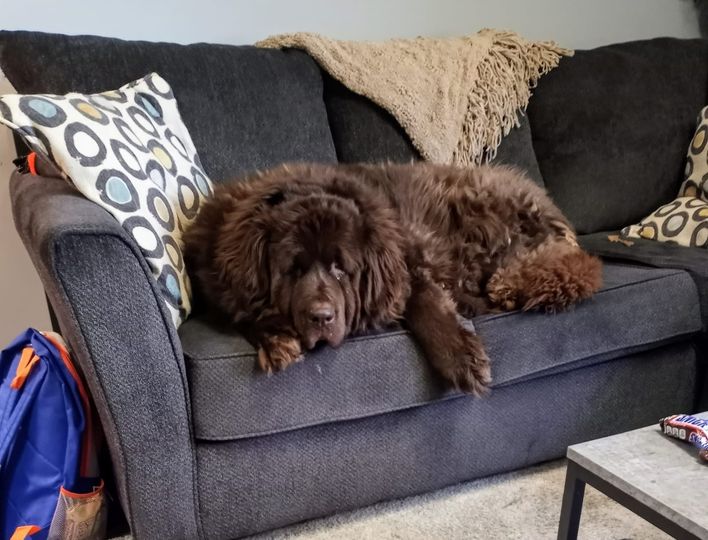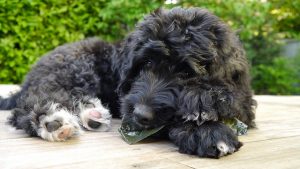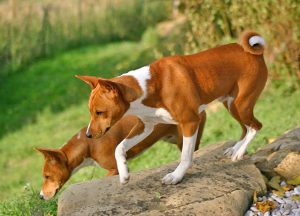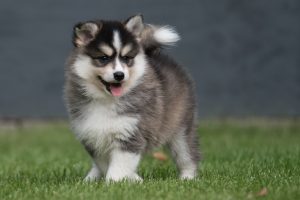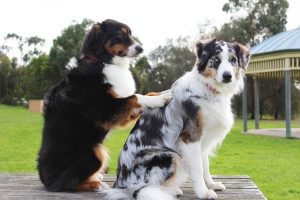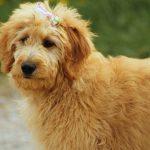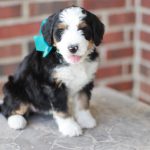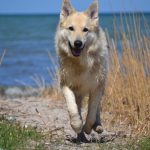Newfiedoodle has so much to offer since it’s a blend between the gentle giant; Newfoundland, and the intelligent and friendly dog; Standard Poodle.
Gorgeous, polite, and easily understandable! The Newfiedoodle dogs give most households a pleasant addition. However, they need a lot of space and the owners should make sure that they are capable of providing them with no less than one hour of entertainment, exercise, walks, and other necessary activities every day.
If you are looking for a comprehensive guide about Newfiedoodle dogs, you are in the right place. In this article, you’ll find everything you need to know about this wonderful breed before getting a puppy.
So, let’s explore more about Newfiedoodle.
Read about Saint Berdoodle
Table of Contents
History and introduction to Newfiedoodle
Also known as Newfypoo and Newfydoo, this large-sized breed has become very popular recently. While looking for its origin, we didn’t find any evidence regarding the place and time of its first-ever breeding but it is assumed that it was bred in the US within the last couple of decades.
It is mainly a large-sized dog having a stunning face with a dumb and hairy coat. These dogs have huge heads and strong, muscular bodies with a tail that, in their latter part becomes quite wavy. The color of their eyes may be amber or a bit brownish and a sweet and trusting smile is often presented. Owners should prepare themselves for a puppy that doesn’t stop growing and has the ability to hit heights over 50cm.
Quick facts about the parent breeds
Newfoundland

This Canadian dog was used as a working dog, mostly with fishermen as net-pullers. These hardworking dogs work tirelessly and are excellent swimmers. Despite their large size, they are sweet, humble, and family-oriented dogs. The Newfiedoodle is more likely to inherit Newfoundland’s size, loving personality, and ability to swim.
This gentle giant originated in Newfoundland, Canada. It is an easily-trainable dog with the potential to become an ideal therapy dog. Overall it is a healthy dog breed but is prone to various diseases such as hip and elbow dysplasia, cherry eye, epilepsy, and cataracts. To keep the puppies from such diseases, it is recommended to get the parents tested for such genetic diseases, and if found, they shouldn’t be bred at all.
Other popular mixes of the Newfoundland dogs are Bernefie (crossed with Bernese Mountain Dog), Golden Newfie (crossed with Golden Retriever), and New Rottland (crossed with Rottweiler).
Poodle

Poodles are excellent companion dogs around the world known for their intelligence and agility. They are elegant, talented, and affectionate dogs that love to spend quality time with their human families.
Poodles come in several sizes and a plethora of colors. One of their most popular traits is the curly coat that rarely sheds making them an ideal breed for people with allergies. Due to their highly intelligent nature, they are needed to be trained from an early age or they may get destructive. Newfiedoodles may inherit their low-shedding coats, intelligence, and loving personality.
Poodles have been crossed with dozens of other breeds for decades and the popular ones are Labradoodles (crossed with Labrador), Cavoodles (crossed with Cavalier King Charles Spaniel), Goldendoodles (Golden Retriever cross), and Bernedoodles (Bernese cross).
Appearance
Most Newfiedoodle dogs have that much height and weight that people can easily identify these giants in a pack of hundreds of dogs. They would usually be more compact and thin than the dumpy and bulky Newfoundland, taking over the Poodle’s more stylish silhouette. As far as the skull and muzzle are concerned, these are still broader than the typical dogs but not so large as compared to Newfoundland’s.
Their bodies are a bit rectangular in shape. However, their limbs are stretched and in a straight line. Their tails reach their hocks and sometimes twist at the tip. The Newfiedoodle weighs anywhere between 30 to 70 kilograms when mature and reaches heights of 50cm to 60cm.
They usually have a hypoallergenic coat, but it is never ensured, and they may shed small or large quantities of hair depending on the tendency of the parent breed. Their coats are average-sized and mostly wavy, while their skins typically look very hairy and thick. They come in several colors including black, brown, and grey.
Related: Bernedoodle dog
Temperament and behavior
The nature of a hybrid dog is not easily predictable as compared to a purebred dog, but many Newfiedoodles have quite similar personality traits. They are very friendly, and even-tempered, and would be eager to be in the squad of just about everyone if they are well-socialized.
They usually welcome people of almost all ages; from kids to elders which makes them a good companions for aged people, as well as, children. In their presence, infants need constant supervision, simply because of their abrupt size and sheer strength. Moreover, if you already have a small dog such as a Chihuahua, or other small pets in your home, you need to supervise them whenever they are together. It would be better not to get a Newfiedoodle if you have infants and/or small pets at home.
They show great obedience to their families and are intensely protective of them. While they seldom display aggression to an outsider or a house breaker, their sheer size and deep roar and bark are sufficient enough to scare away everyone! The Newfiedoodle is quite alert and very clever, loves being a part of family life, and loves the possibility of engaging in a move. When under-stimulated, they hate being put to their own devices for a very long time and may get bored.
Trainability
The Newfiedoodles are quite fun to train with a flexible attitude. To learn a new trick, they figure it out quickly and require a bit of repetition. They respond better to positive support and are clearly motivated by occasional treats so rewards during the training sessions are highly recommended.
When owning a big and strong dog, a high standard of training is important. It is important for them to learn simple tasks, and react when called upon, from a young age. Similarly, it is important to socialize and teach dogs good behaviors from puppyhood. Consistency is crucial and during the training sessions of Newfiedoodles, the majority would succeed.
Common Health-related issues and concerns
There are several diseases and conditions that the Newfiedoodle is vulnerable to, similar to any other dog, and that both breeders and prospective owners should be aware of.
Hip Dysplasia
If the long leg bone is unable to fit into the hip socket as it has to, Hip Dysplasia arises, and the joint grows abnormally. Undoubtedly, as they start growing older, the dog will be suffering from hip arthritis for sure. For many, the bigger the dog, the lesser their ability of them to deal with mobility problems, and treatment of hip dysplasia may prove to be disastrous. It is a very painful disease and must be treated right away.
Bloat
An occurrence of bloat may happen unexpectedly and with little notice, a potentially destructive disorder that may kill your dog instantly. In this disease, the belly of the dog is spread and the dog feels difficulty settling itself. It is strongly recommended to bring your animal for diagnosis and treatment to the veterinary clinic as early as possible, so that the chances of its survival may increase.
Heart Diseases
Various heart problems are considered to be more common than a few other breeds in the Newfiedoodles. To prevent these heart problems from being transferred to future generations, the propagation or breeding of such animals should be examined and avoided if a genetic disorder is found.
Exercise and Activity Levels
The Newfiedoodles are in no need of an enormous amount of exercise every day. Although large and not lazy at all, they are generally satisfied with just a single solid hour. They really like to wander around and catch balls and frisbees. They love swimming, and you’ll see them doing so with no concern at all for the outside temperature. Interestingly, they inherit their love for swimming from the Newfoundland dog that loves swimming in rough water.
When exercising these dogs, the owners need to be careful because over-exercising would lead them to joint problems in the latter part of their life. An exercise regimen should be addressed with their vet, depending upon their size and shape, to ensure that it will not be harmful to the developing bones. Remember, joint and bone-related conditions are painful and large-sized dogs suffer a lot from them.
Grooming requirements
You should comb or brush your Newfypoo’s dense fur regularly to avoid mats and tangles. If your dog has a curly or wavy coat that usually sheds less, you are more likely to groom it more often.
You should prepare your pup from a very young age to get used to routine activities including claw clipping and teeth brushing. The reason is that training a mature dog for the very first time when it is more powerful than a calf isn’t easy at all!
Newfiedoodle FAQs
How big is a fully-grown Newfiedoodle?
You should expect your Newfiedoodle dog to grow up to 28 inches and weigh up to 160 pounds.
Is it a good family dog?
Yes, these dogs are excellent family pets but not suitable for families with infants and smaller kids due to their size.
Are they prone to separation anxiety?
If they are not trained to be alone from an early age, they may develop separation anxiety.
Do they shed more or less?
They usually have a low to no-shedding coat so they are an ideal breed for people with allergies.
Bottom line
Newfiedoodle is a lovely dog that needs to be handled with love and it is all yours. Despite its large size, it will be ready to spend its time in your lap. If you have enough space for this loving giant, you should get one for sure.
Recommended read – How to keep your dog active in Canada’s Winter
Image credit: Newfypoo Zoo

